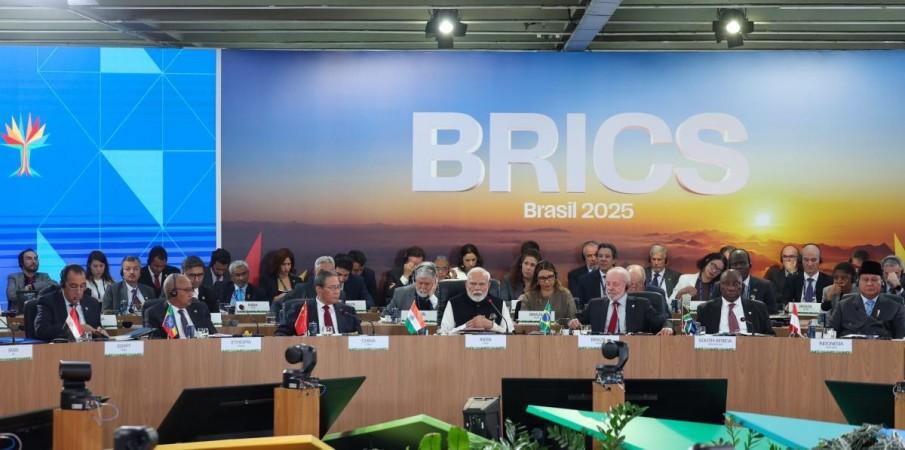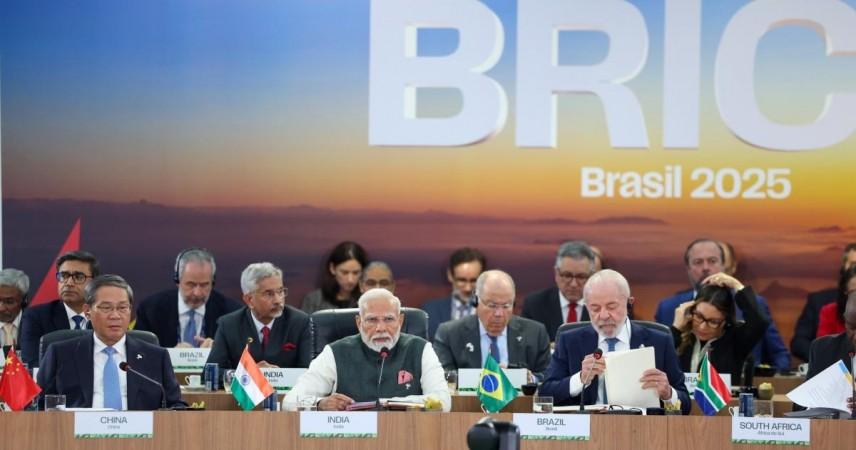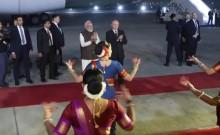
The 17th BRICS Summit, convened in Rio de Janeiro, Brazil, on July 6-7, 2025, marked a defining moment for the bloc's ambition to reshape global governance. Under the theme "Strengthening Global South Cooperation for More Inclusive and Sustainable Governance," BRICS Plus, now encompassing 10 full members and 10 partner countries, unveiled transformative initiatives to challenge Western-dominated systems.
The Rio de Janeiro Declaration, Indonesia's induction as the 10th member, and bold commitments signal a multipolar shift. Yet, the absence of key leaders, U.S. tariff threats, and overlapping global institutions raise questions about BRICS' efficacy and coherence. Its thus important to analyze the summit's outcomes, their strategic implications, and BRICS' role in a crowded global landscape, and offer a meaningful perspective on the imperatives for India and the world.
Rio 2025: Key Outcomes and Strategic Implications
The 17th BRICS Summit produced 126 commitments across six pillars, reinforcing its role as a platform for Global South leadership. The Rio de Janeiro Declaration, adopted unanimously, emphasized multilateralism, sustainable development, counterterrorism, and AI governance. Key outcomes include:
1. Membership Expansion: Indonesia joined as the 10th full member, alongside Brazil, Russia, India, China, South Africa, Egypt, Ethiopia, Iran, Saudi Arabia, and the UAE. Ten partner countries (Algeria, Belarus, Bolivia, Cuba, Kazakhstan, Malaysia, Nigeria, Thailand, Uganda, Uzbekistan) were welcomed, enhancing BRICS' reach. Representing 45% of the global population and 30% of GDP, BRICS Plus rivals the G7's $48 trillion economy.
2. Global Health Cooperation: The BRICS Partnership for the Elimination of Socially Determined Diseases and Neglected Tropical Diseases aims to ensure equitable access to medicines and vaccines, addressing post-COVID disparities. This aligns with UN Sustainable Development Goals but prioritizes Global South needs.
3. Trade, Investment, and Finance: The summit advanced de-dollarization, with 15% of global trade exploring non-dollar mechanisms by 2025. The New Development Bank (NDB) launched a Multilateral Guarantees initiative to lower financing costs, having disbursed $35 billion across 96 projects. BRICS Pay, piloted in Brazil-India trade (5% of transactions), challenges SWIFT. A new NDB-linked investment platform was announced, bolstering economic resilience.
4. Climate Change: The BRICS Climate Leadership Agenda and Leaders' Framework Declaration on Climate Finance target $200 billion annually, addressing COP's $100 billion shortfall. China and the UAE pledged support for Brazil's Tropical Forests Forever Facility, countering U.S. climate policy shifts under President Donald Trump.
5. AI Governance: Leaders called for ethical AI frameworks, balancing regulation with innovation. India's announcement of a 2026 AI Impact Summit positions it as a tech leader, with BRICS' 20% share of global tech investments amplifying its influence.
6. Peace and Security: The summit condemned terrorism, specifically India's April 2025 Pahalgam attack, demanding zero tolerance for terror sponsors. It supported Palestine's UN membership and cautiously addressed Gaza's humanitarian crisis, avoiding direct criticism of Israel or Russia's Ukraine conflict. Calls for UN Security Council reform reflect BRICS' push for multipolarity.
These outcomes position BRICS as a counterweight to Western institutions, with the NDB and BRICS Pay challenging IMF/SWIFT dominance. Indonesia's membership strengthens Asia-Africa-Latin America ties, but rapid expansion risks diluting cohesion, as evidenced by the April 2025 foreign ministers' failure to issue a joint statement.
The absence of China's Xi Jinping, Russia's Vladimir Putin, and Iran's Masoud Pezeshkian, replaced by Premier Li Qiang, Foreign Minister Sergei Lavrov, and Foreign Minister Abbas Araghchi, signals commitment gaps, potentially undermining BRICS' authority. Trump's 10% tariff threat, targeting BRICS' "anti-American" policies, underscores the bloc's geopolitical weight but risks trade disruptions, particularly for export-dependent Brazil and India.
The Crowded Global Stage: Overlapping Charters and Diluted Sanctity
The global governance landscape is a mosaic of overlapping institutions. The UN, with 193 members, pursues peace and development, but Security Council vetoes stall action (e.g., Gaza resolutions). The IMF and World Bank, managing $1 trillion in lending, enforce Western-aligned policies, with the U.S. holding 16-17% voting shares. The G7 ($48 trillion GDP) coordinates advanced economies, while the G20 (85% of global GDP) struggles for consensus amid U.S.-China rivalries. The WEF shapes elite agendas, and COP's Paris Accord, binding 196 nations, falters on enforcement, with 2024 emissions projected to rise 2.7% above 2010 levels.
BRICS' six pillars overlap with UN SDGs, G20 economic goals, and COP climate targets, risking redundancy. The sanctity of decisions varies: UN Security Council resolutions are binding but often disregarded (e.g., Israel's non-compliance); IMF conditions are enforced but criticized; G7/G20 declarations are aspirational; and BRICS' non-binding commitments, like the Rio Declaration, rely on consensus, vulnerable to internal divisions.
Efficacy: A Mixed Record Across Institutions
Efficacy depends on implementation, inclusivity, and influence. The UN's $3.4 billion peacekeeping budget supports 70,000 troops, but vetoes undermine conflict resolution. The IMF's $650 billion Special Drawing Rights allocation in 2021 stabilized economies, yet austerity burdens developing nations. The G7's $100 billion climate pledge remains unfulfilled, while the G20's 15% corporate tax deal progresses slowly. COP's 1.5°C target is elusive, and BRICS' NDB, while effective ($35 billion disbursed), struggles with de-dollarization scale (10% of India-Russia trade in rupees).
BRICS' expansion enhances legitimacy but risks inefficiency. The absence of key leaders at Rio 2025 and diverse interests, China's $18 trillion GDP versus South Africa's $400 billion, complicate cohesion. Yet, BRICS' advocacy for Palestine and UN reform amplifies Global South voices, challenging Western dominance.
BRICS and Global Institutions: Complementary or Competitors?
BRICS complements UN principles (sovereignty, non-interference) but critiques Security Council inertia, pushing for reforms to include India and Brazil. The NDB and $100 billion Contingent Reserve Arrangement rival the IMF/World Bank, offering loans without Western conditions, 70% of NDB projects target African/Asian infrastructure. In the G20, BRICS nations amplify Global South priorities, but their Climate Leadership Agenda and AI Summit compete with COP and WEF, emphasizing equity.
BRICS influences global norms, with 15% of trade exploring non-dollar mechanisms and support for Palestine's UN membership. However, U.S. resistance, via dollar dominance (60% of global reserves) and tariff threats, limits its disruptive potential.
U.S. Dominance: A Formidable Influence
The U.S. wields unmatched influence through economic ($26 trillion GDP), military (NATO), and institutional levers. Its 22% UN budget contribution and veto power shape security agendas. The dollar and SWIFT enable sanctions, isolating Russia ($300 billion in frozen assets) and Iran. In the IMF/World Bank, U.S. voting power ensures Western policies, while the G7 sets economic norms. Trump's tariff threat targets BRICS' de-dollarization, risking India's $500 billion U.S. trade surplus.
BRICS counters with NDB funding, BRICS Pay, and local currency trade (e.g., Brazil-India pilot). The Rio Summit's tariff condemnation signals defiance, but economic retaliation looms.
China's Ascendance and Russia's Resilience
China: With an $18 trillion GDP and $3 trillion in Belt and Road investments, China drives BRICS' economic agenda, funding 41% of the NDB. Its $12 billion UN contributions and 2,500 peacekeepers bolster diplomacy. China's push for BRICS expansion (Iran, Ethiopia) and alternatives (AIIB, $100 billion in projects) challenges U.S. dominance. Xi's absence at Rio 2025, possibly due to scheduling or caution, underscores tensions with India and Brazil over leadership.
Russia: Facing sanctions and ICC warrants, Russia leverages BRICS to resist isolation. Its $1.8 trillion GDP and energy exports (40% of India's oil) sustain influence, but reliance on China (20% of trade in yuan) limits autonomy. Putin's virtual attendance at Rio reflects legal constraints, yet Russia's advocacy for de-dollarization and UN reform maintains relevance.

India's Strategic Balancing Act
India ($3.7 trillion GDP, 1.4 billion population) is a BRICS linchpin but faces challenges. China's dominance and new members dilute its influence, yet Prime Minister Narendra Modi's Rio interventions, condemning the Pahalgam attack, securing COP33 support, and announcing the AI Summit, demonstrate intent. India's rupee-ruble trade (10% of $50 billion with Russia) and NDB projects ($8 billion) yield gains, but balancing BRICS' anti-Western rhetoric with U.S. partnerships (Quad, $120 billion trade) is complex. India's neutral stance on Gaza and Ukraine reflects non-alignment but risks indecision.
Future Imperatives: A Multipolar Vision
BRICS Plus heralds multipolarity, challenging Western systems. Its 45% population share and 30% GDP amplify Global South voices, but cohesion is critical. De-dollarization (15% of trade in local currencies) requires stability to avoid disruption. Climate finance ($200 billion target) must bridge COP gaps, and AI governance could set global standards.
Regionally, BRICS drives African infrastructure (30% of NDB projects), Asian connectivity (Indonesia, Malaysia), and Latin American autonomy (Brazil). India must leverage BRICS for UN reform, climate leadership, and trade while navigating U.S.-China rivalries. Globally, BRICS demands inclusive governance, with reformed UN and IMF structures reflecting emerging economies.
A Defining Moment
The Rio 2025 Summit positions BRICS Plus as a transformative force, with the Rio Declaration and expanded membership signaling multipolar ambitions. Yet, leadership absences, U.S. tariffs, and institutional overlaps challenge its efficacy. The U.S.'s formidable influence faces resistance from China's rise and BRICS' initiatives, while Russia clings to relevance and India balances strategic imperatives. As a soldier-scholar, I see BRICS as a clarion call for equity in a fractured world. Its success hinges on unity, not rivalry, to forge a sustainable, multipolar future.
[Major General (Dr.) Dilawar Singh is a retired Indian Army officer and strategic analyst specializing in geopolitics and global governance.]









![Sky is the limit: IndiGo is now tenth largest airline by capacity globally; growth indisputable [details]](https://data1.ibtimes.co.in/en/full/767455/sky-limit-indigo-now-tenth-largest-airline-by-capacity-globally-growth-indisputable-details.jpg?w=220&h=135)